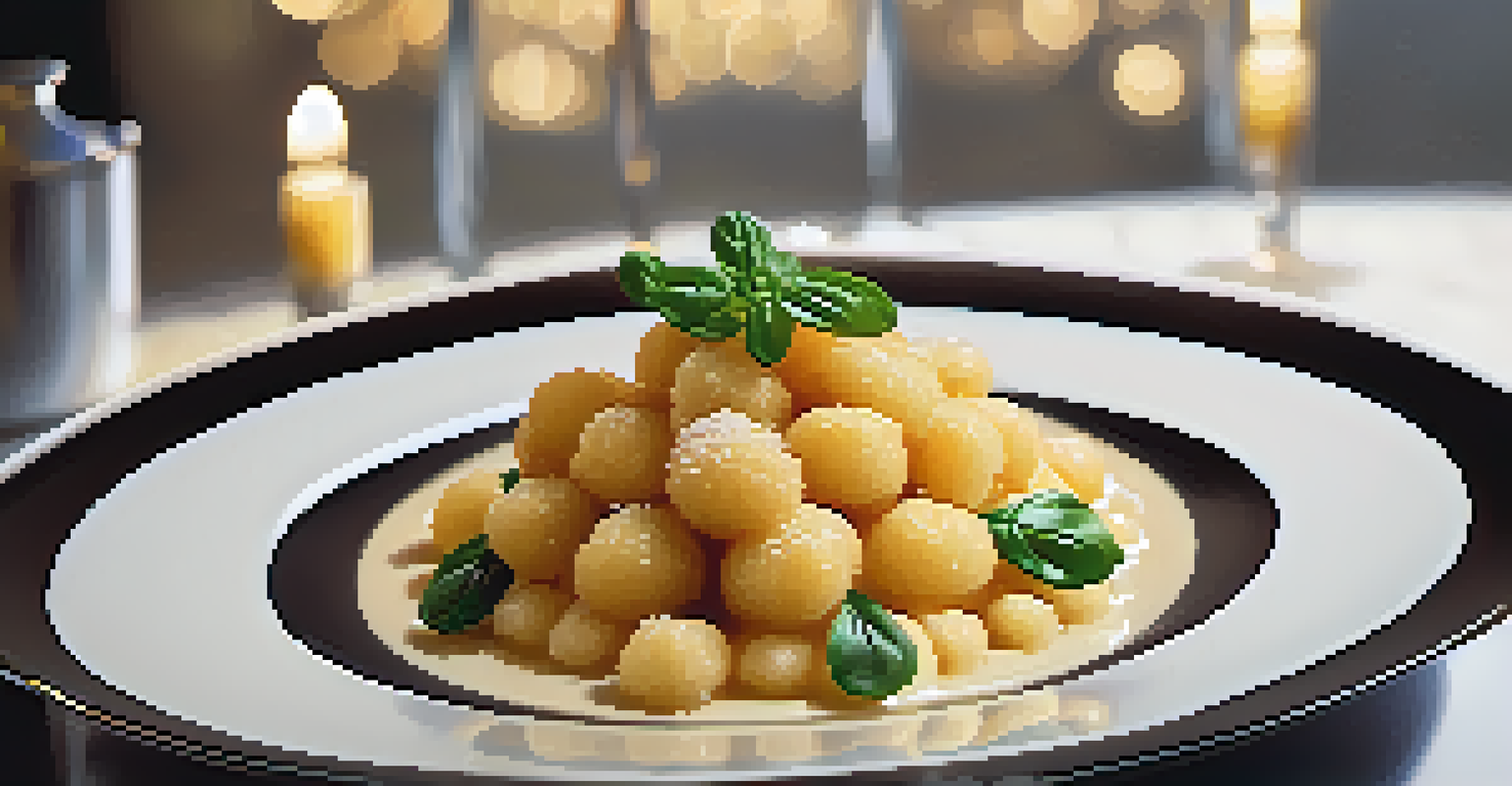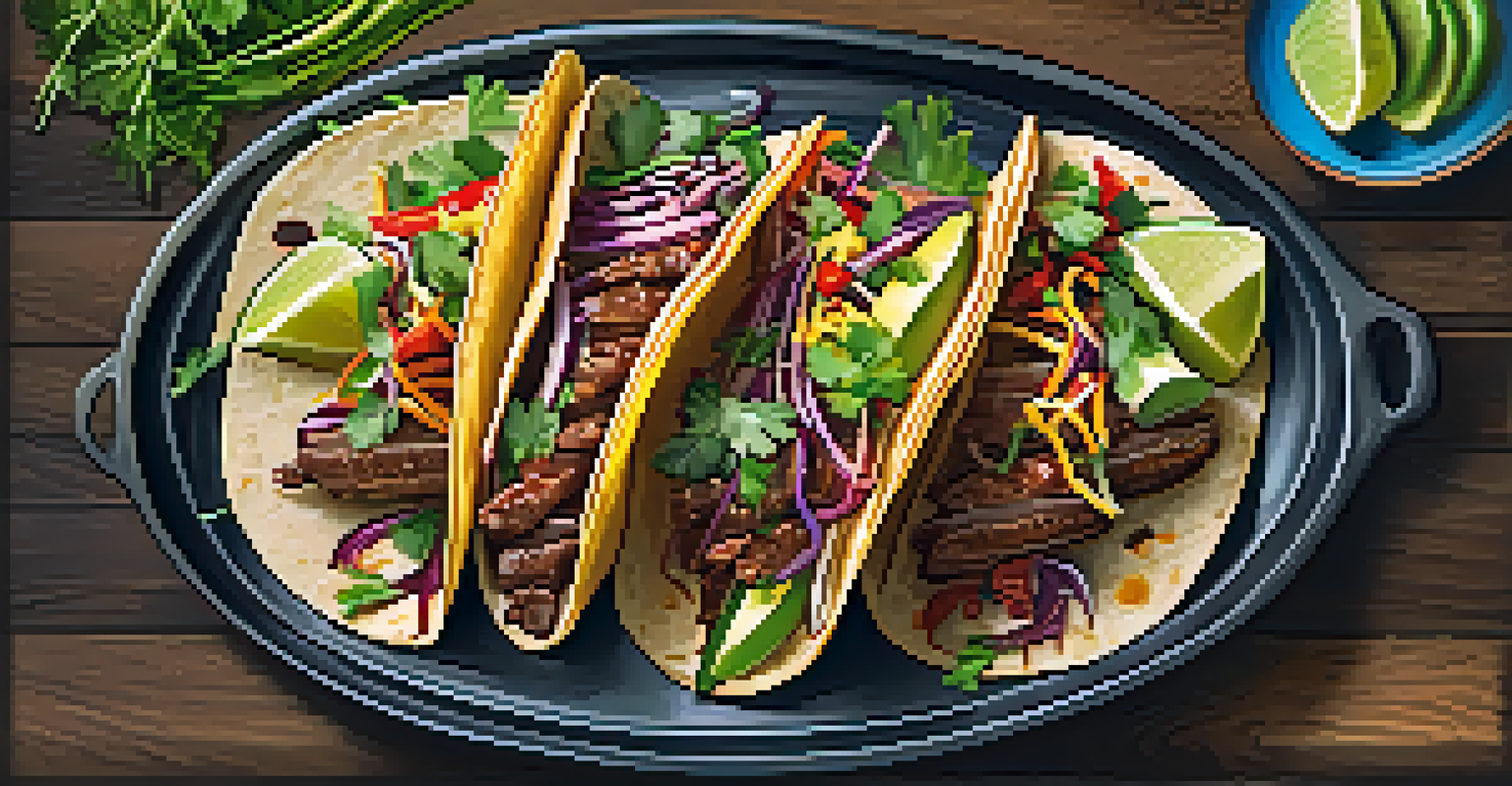Exploring Culinary Art: The Fusion of Food and Painting Techniques

The Intersection of Culinary and Visual Arts
Culinary art and visual arts may seem worlds apart, but they share a common ground rooted in creativity. Much like a painter selects colors to evoke emotions, a chef chooses ingredients to create a sensory experience. This intersection allows chefs to express their artistic vision through food, turning every dish into a canvas.
Food is art, and it is a way of expressing oneself.
For instance, think of a vibrant plate of sushi artfully arranged to resemble a blooming flower. This not only showcases the chef's skills but also invites diners to appreciate the beauty of what they are about to eat. Such presentations can spark conversations, turning a meal into an experience that transcends mere sustenance.
As we delve deeper into this fusion, we can uncover how techniques from painting are increasingly influencing the culinary world. From plating styles to the use of colors and textures, the artistry involved in food preparation is on a trajectory of continuous innovation.
Color Theory in Culinary Creations
Color theory, a fundamental aspect of painting, plays a crucial role in how we perceive food. Just as artists use color combinations to create harmony or contrast, chefs can elicit emotional responses through their choice of ingredients and presentation. Bright colors often signify freshness and flavor, enticing diners before they even take a bite.

For example, a dish featuring a rainbow of vegetables not only looks appealing but can also convey messages about health and vitality. This visual appeal encourages people to explore flavors they might not have considered otherwise, broadening their culinary horizons. It’s the perfect marriage of sight and taste, where colors tell a story.
Culinary Art Meets Visual Aesthetics
Chefs use presentation and plating techniques to transform dishes into visual masterpieces, enhancing the dining experience.
Moreover, the psychology of color can influence appetite and satisfaction. Understanding these nuances allows chefs to craft dishes that not only taste great but also look beautiful, making the dining experience far more enjoyable.
Plating Techniques Inspired by Painting
Plating, the art of presenting food on a plate, is where culinary art truly shines. Much like how an artist composes a painting, chefs design their plates with careful consideration of layout and balance. Techniques borrowed from painting, such as layering and asymmetry, can transform a simple meal into a work of art.
The only thing better than talking about food is eating it.
Imagine a dish where a drizzle of sauce elegantly frames a carefully arranged stack of ingredients, reminiscent of brush strokes on a canvas. This not only enhances the aesthetic but also guides the diner’s experience, leading them to explore the flavors in a specific order. Each element on the plate plays a role in the overall narrative.
Through these artistic techniques, chefs have the power to elevate the dining experience from ordinary to extraordinary. The visual appeal of a well-plated dish can captivate diners even before they savor the first bite, heightening their anticipation.
Texture: The Unsung Hero of Culinary Art
While color and presentation are often celebrated, texture is a vital yet frequently overlooked component of culinary art. Just as painters manipulate texture to create depth and interest, chefs use various cooking methods to enhance the tactile experience of a dish. This interplay of textures can make a meal unforgettable.
Consider a classic dish like gnocchi, where the pillowy softness contrasts beautifully with a crispy topping. This textural contrast not only delights the palate but also adds a layer of complexity to the eating experience. Diners are drawn into the dish, exploring the sensations with each bite.
Color and Texture Enhance Flavor
The strategic use of color and texture not only beautifies dishes but also influences diners' perceptions and enjoyment of food.
By understanding the importance of texture, chefs can craft dishes that engage all the senses, creating a memorable dining experience. This is where culinary art truly flourishes, as the harmony of flavors and textures comes together to tell a compelling story.
Cultural Influences: A Palette of Flavors
Culinary art is often a reflection of cultural heritage, much like painting captures the essence of a society. Chefs worldwide draw inspiration from their backgrounds, weaving traditional techniques into modern interpretations. This blending of cultures creates a vibrant tapestry of flavors that enriches the dining experience.
For instance, fusion cuisine combines elements from different culinary traditions, resulting in innovative dishes that surprise and delight. A perfect example is the Korean BBQ taco, which marries the bold flavors of Korean cuisine with the beloved format of a Mexican taco. This not only showcases the versatility of food but also emphasizes the beauty of cultural exchange.
As diners explore these cultural fusions, they embark on a journey through flavors and stories, much like an art lover exploring different styles in a gallery. This culinary exploration invites people to appreciate the richness of diverse backgrounds and encourages a greater understanding of the world.
The Role of Presentation in Fine Dining
In the world of fine dining, presentation is everything. High-end restaurants often treat their dishes as works of art, paying meticulous attention to every detail. This level of presentation enhances the overall experience, making each meal feel like a special occasion, akin to attending an art exhibition.
Imagine stepping into a restaurant where the first course arrives, beautifully arranged with edible flowers and delicate sauces. This not only excites the senses but also sets the tone for the entire meal, creating an atmosphere of anticipation. Diners are more likely to savor each bite, appreciating the artistry behind every dish.
Cultural Fusion Creates Unique Dishes
Blending culinary traditions leads to innovative fusion cuisine, enriching the dining experience and celebrating diverse cultural heritages.
Through stunning presentation, chefs can evoke emotions and inspire memories, turning a simple dinner into a cherished experience. This connection between food and art highlights the power of culinary creativity, reminding us that dining is not just about nourishment, but about experiences and connections.
Food as a Form of Artistic Expression
At its core, culinary art is a form of expression, much like painting or sculpture. Chefs use their skills to communicate ideas, emotions, and narratives through food. Each dish they create can tell a story, inviting diners to engage with their artistry on a personal level.
For instance, a chef might craft a dish inspired by their childhood memories, encapsulating flavors that evoke nostalgia. This emotional connection can transform a meal into a journey through time, allowing diners to relive moments of joy and comfort. Food becomes a vessel for storytelling, bridging the gap between the chef and the diner.

As we celebrate the fusion of food and painting techniques, we recognize that culinary art is not just about taste; it's about sharing experiences and emotions. This profound connection elevates food beyond mere sustenance, inviting us to explore the deeper meanings behind each bite.